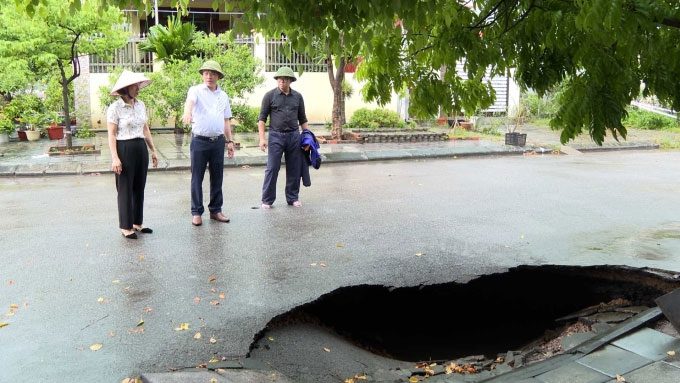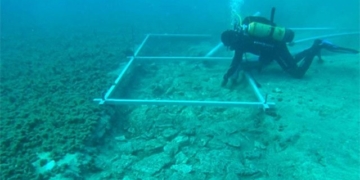According to experts from the Institute of Geology, the phenomenon of land subsidence in some residential areas is caused by the soil layer above the carbonate rock being eroded into the underground karst caves below.
The land subsidence in the Nam Son 2 area of Cam Pha, Quang Ninh, which occurred from July 30 to the morning of August 1, resulted in a 2.5-meter deep and 5-meter wide depression in the asphalt road and a section of the sidewalk.
Dr. Tran Quoc Cuong from the Institute of Geology, Vietnam Academy of Science and Technology, stated that there are two main factors causing the sinkhole (commonly referred to as a “death hole”) in the coastal area of Cam Pha. First, the development of underground karst caves and the presence of a weak soil layer in the coastal region. Second, there are stimulating factors, such as fluctuations (rising and lowering) of the groundwater level related to tides and rainfall, as well as the increased load from structures and fill soil.
In the fault systems in Cam Pha, the Northwest-Southeast fault system is a young fault system that is spatially related to the locations of the sinkholes. The intersections of these fault systems are areas where underground karst cave systems develop strongly. The geological and tectonic structures are also believed to be an indirect cause, facilitating the subsidence process.

The subsidence process is illustrated in the image below, showing an example of a sinkhole located directly above the karst underground space (drainage area). The development process from a to d is illustrated, where 1 (carbonate rock) and 2 (the weak rock layer covering the surface of the underground carbonate rock).
In Vietnam, regions with similar geology have experienced land subsidence related to karst underground spaces, such as Quy Hop, Nghe An, Thuy Nguyen (Hai Phong); Bang Lung, Cho Don (Bac Kan). In Quy Hop, Nghe An, there were as many as 11 subsidence points within just two months in 2021. Many sinkholes were 2-7 meters wide and 2-2.5 meters deep.
Research from the Institute of Geology indicates that in coastal areas, the soil layer above the carbonate rock (limestone) is eroded, leading to underground karst caves beneath. Due to stimulating factors, the materials of the weak soil layer are washed away and drawn into the underground space through cracks and fracture zones in the carbonate rock at the cave ceiling. The loss of the weak layer can also occur at karst funnels. The development of fill soil, especially in coastal reclamation areas, also contributes to the acceleration of subsidence processes. Additionally, a noteworthy stimulating factor is the fluctuation of groundwater levels related to tides and rainfall.
According to Mr. Cuong, there is a need for more detailed assessments to serve urban management efforts and mitigate the impacts of land subsidence disasters.

A sinkhole approximately 2.5 meters deep and 5 meters in diameter appeared in Cam Pha City. (Photo: Bao Long).
According to experts from the Institute of Geology, residents can identify signs of land subsidence through unusual depressions or sinkholes on roadways, wall cracks, signs of water loss, or sudden spikes in water consumption as measured by meters (due to pipe breaks caused by sinkholes).
For construction projects in areas prone to sinkholes, to minimize property damage, it is recommended to use pile foundations for the structures, Mr. Cuong advised.


















































